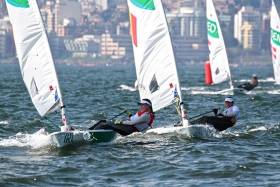Displaying items by tag: Sailing Olympics
Annalise Murphy Gives Ireland's Olympics The Silver Sheen
Annalise Murphy’s Silver Medal has re-focussed sailing’s thinking about the Olympic Games, which tend to be perceived in many ways. It’s understandable that some specialist sportsmen see the Games as a monster which consumes energy which could be better deployed in other ways. Yet what’s the alternative? We live in a globalised age of instant and total communication, hungry for entertainment. To feed this voracious need for sport and spectacle, if the Olympics didn’t exist, then they’d have to be invented. W M Nixon admits he has always regarded the five ring circus with mixed feelings. Yet he readily argues in favour of the promotion and development of the Olympic Games, and their special value for a minority sport like sailing in a small nation like Ireland.
For maybe four weeks of every fourth summer, we are all Olympic fanatics. Then the monster is put back in its cage, and only the truest devotees, the dedicated fanatics, continue to work, plan, think and train, train, train towards the next Games, and the Games beyond that, and the Games beyond that again.
Certainly it’s elitist. And expensive. The remarkable British medal haul from the 2016 Games has shown what can be done with a heavily financed programme which rewards success while ruthlessly eliminating those who aren’t showing themselves capable of achieving the required standard.
Far from being a celebration of amateur sport, it has become a festival of professionalism at the highest level. Yet it has reached to such a level of specialized focus that an extraordinary level of camaraderie develops among the athletes. The way to the games is a long and often lonely path, and only one Olympic athlete can truly understand what his or her competitors have been through simply to be there.
Thus although some other sports such as international professional football can be reasonably if cynically seen as an acceptable substitute for war, the extraordinary thing is that, in its own odd way, the Olympics transcend this. There truly is such a thing as the Olympic Ideal of international goodwill, and it is alive and well even if it is sullied by some jingoistic supporters who use the Olympic success of a dedicated corps of athletes for the crudest nationalistic bombast.
The special nature of the trans-national relationships and friendships between Olympic athletes, and with their supporting teams – sometimes only very few in number – of coaches, trainers, technologists, sports psychologists, nutrionists and whatever, sets them apart from the remoter upper areas of sports administration. And when you’re battling on the front line of top-level sailing, you know that ultimately you must find your own path to success.
It was that and many other factors which contributed to the achievement by Annalise Murphy of Ireland’s Silver Medal for sailing. It was won last Tuesday off Rio de Janeiro after a short but tense race through which the nation held its breath while the sailor from the National Yacht Club emerged successfully from a brief gladiatorial contest. It was a contest which could just as easily have seen her lose the Bronze Medal points position she’d held going into this final double-scoring ten boat race of the best of the best. Yet she emerged clear winner of the Silver.
The jubilation among the entire Irish population at home and abroad was eloquent testimony to the fact that in the Olympics, all sports are equal. A medal in a minority sport like sailing carries the same esteem with the folks at home, however much the adherents of the more traditional stadium athletic, field and track events might like to claim that their area of the games is the only true Olympics.
The fact that she had won it was a reminder that, ultimately, all nations are equal in the Olympics. For sure, the big nations with huge resources and enormous populations from which to draw talent can send large teams in order to be represented in very many disciplines. But in the final analysis, however big or small the nation, however small the national team it sends to the Olympics, and however few the disciplines in which it is represented, in each category there is still only going to be one national representation in each team, crew or personal event.
And even more clearly, in disciplines in which only one person is ultimately involved, there is just that one person out there in competition, whether they’re representing a vast continental nation with a population numbered in the hundreds of millions, or a damp island in the Atlantic where we have only just got back to having upwards of six million people living in the place.
Now that it has happened, the Annalise Murphy Silver Medal seems part of a smooth natural progression, but it was anything but. Her determination towards Olympic success began in 2009, when she put herself forward towards being a contender in London 2012. She’s of a sailing family, with father Con Murphy an international competitor, record breaker and race and sailing administrator (he’s a former Commodore of the National Yacht Club in Dun Laoghaire), while mother Cathy MacAleavey is a successful small boat sailor. Cathy represented Ireland in the 1988 Olympics, established a round Ireland sailing record, and has since become a leading light in the classic sailing dinghy movement. So for Annalise, inevitably serious sailing - and encouragement for it - was in the family genes.
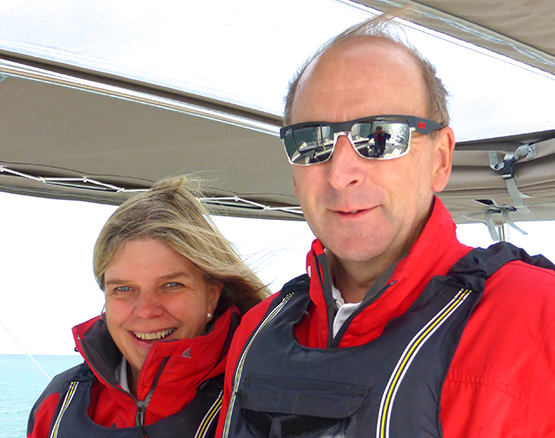 Cathy MacAleavey and Con Murphy Photo: WM Nixon
Cathy MacAleavey and Con Murphy Photo: WM Nixon
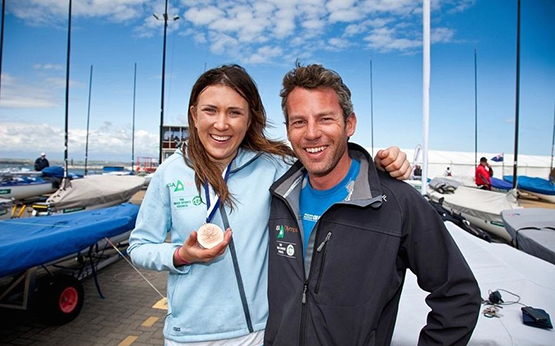 The journey is under way – Annalise Murphy with her longtime coach Rory Fitzpatrick in 2012. Photo courtesy NYC
The journey is under way – Annalise Murphy with her longtime coach Rory Fitzpatrick in 2012. Photo courtesy NYC
But as everyone knows, having been in Gold Medal position in the Women’s Laser Radial at mid-series in the 2012 Olympics, she had it all snatched way by a matter of seconds at the finish of the Medals Race. Until then, a fourth for Ireland in an Olympic event would have been regarded as a major achievement. But there was no disguising the abject disappointment, and it took her maybe six months to get back on an even keel and re-align her sailing targets towards Rio de Janeiro 2016.
It was a daunting prospect, as Rio is notorious for often hyper-light and almost always flukey winds in the sailing waters close in under the steep coastlines and many buildings. But Annalise is known as “Queen of the Breeze”, for she’s tall with a very impressive performance in strong winds, and so well able to apply a ferocious righting moment to a hard-driven sailing dinghy that her colleagues and opponents in the Lasers often refer to her simply as “The Lever”.
 Murphy’s Weather…..but when the breeze built up at the first attempt to stage the Medals Race in Rio on Monday, it became so strong that racing had to be postponed until Tuesday. Photo: World Sailing
Murphy’s Weather…..but when the breeze built up at the first attempt to stage the Medals Race in Rio on Monday, it became so strong that racing had to be postponed until Tuesday. Photo: World Sailing
For someone of this build, Rio de Janeiro’s reputation made it seem the sailing venue from hell. But she determinedly got herself out there as much as possible. Between 2013 and the 2016 Olympiad, she made no less than nine visits, with several of them of extended duration, so much so that by early 2016 there were few non-Brazilians who knew the racing area better.
Yet the strain of keeping up the Brazilian side of the programme while continuing to take part in events of appropriate international standard all over the world was taking its toll. Though she won Ireland a place in the Olympic Women’s Laser Radials for 2016, and then successfully saw off a challenge for that place to go to another sailor, there was no disguising her frustration at her own performance.
It reached a nadir in May 2016 at the Worlds in Mexico, when she finished 39th in a fleet of 71 boats in which she found herself sailing the final races in the Silver Fleet while the sailors with whom she was accustomed to being in top contention, such as Paige Railey of the US, Anne-Marie Rindom of Denmark, Marit Bouwmeester of The Netherlands, Lijia Xu of China, Gintare Scheidt of Lithuania and Alison Young of GB, were out of sight up at the head of the Gold Fleet.
Some day we’ll get the full story of what happened during those next ten weeks to turn the Annalise Murphy story around, to change her from a loser in Mexico in May to a winner in Rio in August. Her support team never gave up on her, and her longtime coach Rory Fitzpatrick and ISA Performance Director James O’Callaghan added extra elements to the programme, including more intensive involvement with the legendary “coach of coaches”, Gary Keegan of the Institute of Sport.
It was a time of psychological and physical challenge, and while her psychologist Kate Kirby was a tower of strength, it was the challenge of “Re-shaping Annalise” for Rio which became central to the plan, for you’d guess that if she still felt she was too heavy for the average conditions in Rio, then she’d start most races with an inbuilt psychological disadvantage.
Rapid weight loss while maintaining peak fitness is not for the faint-hearted, but the Murphy household gave full support by taking all carbs out of the kitchen. Out in Rio meanwhile, it was decided that staying in the Olympic village itself was a calorie hazard, so an AirBnB setup was secured near the sailing base, an arrangement which scored highly on so many points, including maximising diet and nutrition, that you wonder more teams didn’t take this approach.
All this was taking place with the new addition of a key member to the Murphy team. When Annalise missed out so publicly on a medal back in 2012, one of those who shared her disappointment was the New Zealand Women’s Laser sailor Sarah Winthers. Despite having placed 20th overall in 2012, she was completely taken up by the Olympic thing, and devoted her life for the next four years to securing the place in Rio 2016, in which she duly succeeded.
But by this time the New Zealand sailing authorities were applying the same ruthless approach as the British, and they ruled that anyone who failed to get into the top ten in their class’s last world championship before Rio 2016 would not be entitled to take up his or her place.
Sarah Winthers placed 11th in the Laser Worlds in Mexico in May 2016. It was so close that many in the New Zealand sailing community assumed the rules would be stretched. But on the contrary, even an appeal by Winthers to New Zealand’s Sports Tribunal was rejected. New Zealand was not to be represented at all in the 37-strong Women’s Laser Radial fleet in Rio. If some Kiwi tabloids had themselves a bit of righteous indignation about Winthers being left out in the cold, it meant that one hyper-keen sailor found herself lacking a purpose in life when she’d hoped to be preparing for the series she’d dreamt of, for she’s of compact build and Rio’s average sailing conditions might have been devised with Sarah Winthers in mind.
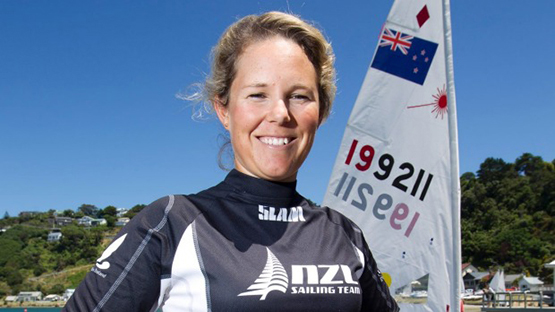 New Zealand sailor Sarah Winthers joined the Murphy team as sailing partner and support coach for the final countdown programme in May, June and July
New Zealand sailor Sarah Winthers joined the Murphy team as sailing partner and support coach for the final countdown programme in May, June and July
But in fact, it may well be that Sarah Winters true vocation is as a coach. For in a very short space of time after rejection by the New Zealand authorities on May 31st, she’d somehow or other become part of the Annalise Murphy team as training sailor and support coach at a time when she could bring something absolutely game-changing to the campaign.
The Murphy camp in its broadest sense was a very happening place in June and July. The weight loss went so well that while conservative reports put it at 7.5 kilos, the word on some grapevines was it might have been as high as 10 kilos in six weeks. Yet thanks to the shared focus and the new intensive sailing programme pacing with Sarah Winthers, Annalise somehow managed to transform herself into a new ultra-slimline version while becoming if anything fitter than ever, and she was very fit to begin with.
Yet it was all kept under wraps. Even public participation in a pre-Olympic series in Rio in July was quietly dismissed as irrelevant, although Annalise was the winner. But it was her final appearance back in Dublin, at the end of July before she returned to Rio for the main event, which made it clear that something sgnificant had happened.
She was in very good form, comfortable with herself and her mind in a good place, and she committed to expectations of being at least in the top eight with a serene confidence which quietened the press gathering, and left everyone with an unmistakable feeling of hope.
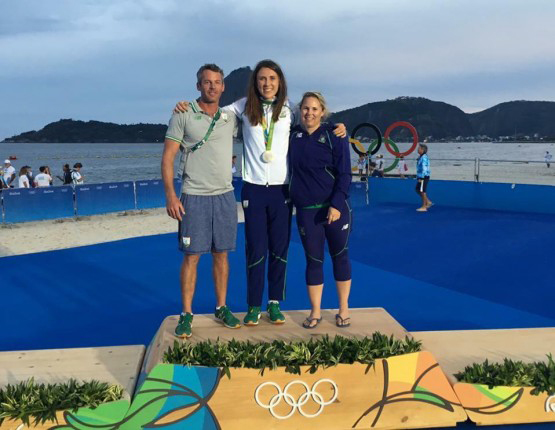 Job done. Rory Fitzpatrick, Annalise Murphy and Sarah Winthers on the Olympic podium.
Job done. Rory Fitzpatrick, Annalise Murphy and Sarah Winthers on the Olympic podium.
Thus there was an impressive amount of effort by a very large number of people going into the Murphy 2016 Olympic Challenge as it got under was on Monday August 8th, and she duly rewarded them by winning the first race with Evi van Acker of Belgium second and Lijia Xu of China third. But for seasoned observers there was a feeling of Groundhog Day about it, as we’d had similar scenarios with the same people back in 2012, yet that went pear-shaped.
And the series by no means proceeded totally smoothly, even if Annalise was generally remarkably consistent, for a 17th in Race 7 had to be carried as surely as several top five places. Yet somehow it all panned out, and by the medals race she was lying third overall knowing she’d to get no worse than fifth to retain that Bronze Medal.
It was a short race, but an awful lot happened in it. Top scorers such as Marit Bouwmeester of the Netherlands and Anne Marie Rindom tended to be in the leading bunch initially, and AnnAlise paced with them, but the at mid-race the other side of the course became favoured and she somehow managed to transfer herself into the other group in a good position, indeed for a crazy 15 seconds there was a possibility of Gold if everyone stayed in the same relative placings.
But in Rio sailing, nothing stays the same for more than two or three seconds, and the final run found Ireland’s hope coming down the middle trying to cover both groups, with the boats on the left making ground with a local freshening. Annalise got herself into contact with them, and it was her rounding of the final mark, a turn to port with a quick close reaching dash to the finish line, which showed her genius.
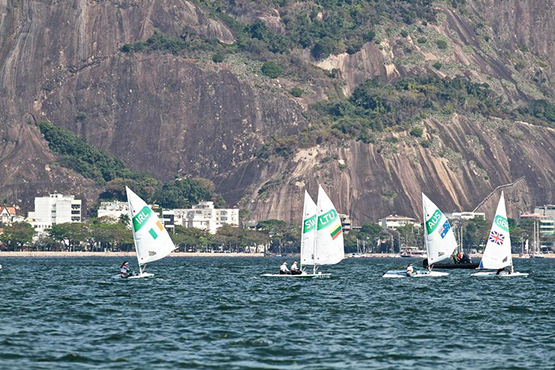
The way it was panning out, the entire group on the left might have swept over her. The worst scenario was that this would leave her so dead in the water that the other group over on the right, with Bouwmeester and Rindom amongst them, may have been trailing for the time being, but showed every sign of coming up with a new breeze, and they in turn could make mincemeat of Irelands hope’s before Murphy had got going again.
She had to engage with the group on the left for some clever mark rounding, for Evi van Acker was zooming up out beyond them, and any errors in Murphy’s management of the mark rounding could see the Belgian making a real challenge. Annalise stayed as cool as you please. She let the leading three boats – none of them of any significance in the overall rankings – go through cleanly, and meanwhile concentrated on shepherding Gintare Scheidt rather closer to the mark in her approach than the Lithuanian might have liked.
In other words, Gintare Scheidt (she’s wife of the Brazilian sailing hero) ran too close past the mark to make a neat rounding, and there was a gap left after she hardened up. Murphy on port meanwhile had been too busy keeping clear of Evi van Acker running down fast on starboard to take up any chance of challenging Scheidt directly, but when she did come to the mark a couple of seconds later, the gap was still there, and Annalise could sail straight to the finish with Scheidt clear under her lee bow and in no way interfering with the Irishwoman’s airflow.
It all sounds so simple. But in mark rounding like this, there’s such a re-shuffling of the pack that two or three places can disappear in as many seconds. Yet Annalise kept her cool and as she came to the line in a sold fifth, it was to realise that she might be looking at silver, for although Rindom, van Acker and Gold Medal winner Bouwmeester were now sweeping towards the line at speed, Annalise Murphy’s race was run, and the Silver Medal was her’s.
Everybody went crazy, and for a while the Danish Bronze Medal boat and the Irish Silver Medal boat were capsized and entwined while their helms swam in that supposedly polluted Rio sea, and the cheers rang out from the Irish contingent on the beach. Somebody even suggested that the boat which had borne Annalise Murohy so gallantly to a Silver Medal might just be left for somebody else to collect, but eventually the two were reunited and in what was now a lovely summer’s evening breeze, the Dane and the Irish girl sailed side by side back to the shore and rapturous welcomes.
So now, what happens to the boats? They were issued fresh from their wrappings to the competitors a few days before the games started. Presumably they’ll go to some deserving cause such as a local youth sailing club? But if nobody’s too sure, how about bringing Annalise’s Rio Laser home for permanent display in the National Maritime Museum? It could usefully show visitors one of the greatest sailing dinghy designs of all time, and it would commemorate a great Irish sailing success. Then too, it would be very useful to have that little boat around the place when the National Yacht Club (founded 1870) celebrates its Sesquicentennial in 2020, when we can only hope that Irish sailing will be having as good a time at the Tokyo Olympics, seeking fair play for a minority sport from a small country, as they did in Rio.
 It really did happen….Annalise Murphy (Silver), Marit Bouwmeester (Gold) and Ann-Marie Rindom (Bronze)
It really did happen….Annalise Murphy (Silver), Marit Bouwmeester (Gold) and Ann-Marie Rindom (Bronze)


























